IceCube science
To find some of the smallest things in the universe, scientists have to think big
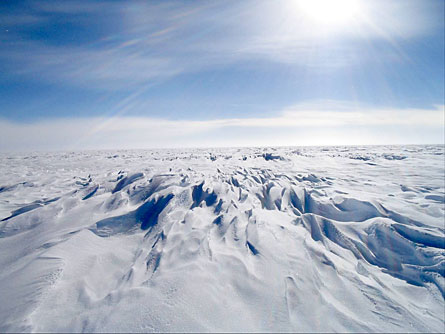 |
|
The South Pole has the most extreme weather conditions on Earth, but some scientists think it’s the best place to watch for neutrinos.
|
| Francis Halzen/NSF |
Francis Halzen has an unusual job. This scientist studies itsy bitsy, teeny tiny objects zipping through the universe. They’re called neutrinos.
His job should be easy because neutrinos are all around us, all the time. They pass from the depths of outer space to the depths of your sock drawer — and then just keep going. And don’t even think about trying to count these super-tiny particles. The neutrinos flying around our universe outnumber all of the people, animals, plants, satellites, planets, stars, galaxies, black holes and asteroids combined.
They’re also fast, traveling at almost the speed of light. In the time it took you to read the previous paragraph, more than a trillion neutrinos zoomed through you.
They always travel in straight lines. Some fly from your eyes to your ears, others from your feet to your head. They fly from the left, from the right and from everywhere in between. Although you can’t see them, they’re also flying through everything you can see.
So you would think Halzen’s job at the University of Wisconsin-Madison should be a snap. All he has to do is catch a few of the gazillions passing through his university every day.
But they are so small and fast that they can fly through almost anything without leaving a trace. Not even photons, the “particles” that carry light, can do that. Neutrinos are so amazingly hard to see that some scientists have taken to calling them “ghost particles.”
“Neutrinos are one of the most common particles in the universe, but in some ways one of the hardest to capture,” says Jim Madsen of the University of Wisconsin-River Falls. Like Halzen, he looks for neutrinos.
Even Wolfgang Pauli, the first scientist to think of neutrinos, had his doubts. He reportedly wrote in a letter, “I have done a terrible thing. I have invented a particle that cannot be detected.”
Since Pauli’s time, scientists have found ways to build neutrino detectors and search for the strange particle. Halzen is in on the hunt. He is leading a team of scientists building a neutrino detector at the bottom of the world, not far from the South Pole. The machine, called IceCube, is about half done.
When complete, IceCube will be the largest scientific instrument in the world, the size of about 1,000 Empire State Buildings. Isn’t it strange that to find the smallest thing, scientists will have to use the biggest machine?
Why bother looking for neutrinos? These tiny particles can tell us about black holes and exploding stars. Scientists at the South Pole believe IceCube might also pull back the curtain on outer space, revealing strange new things that we can’t yet even imagine.
Tiny ghosts from outer space
Neutrinos travel in straight lines, passing right through almost every kind of matter without changing direction. That means “we can use these particles to bring us information from regions of space that other things can’t,” explains Doug Cowen, an IceCube scientist at Pennsylvania State University in University Park.
Take the area around black holes, for example. Believed to exist at the core of most galaxies, black holes are ultra-compact objects with a mass millions to billions of times that of our sun. They’re difficult to study because they absorb most kinds of radiation, including visible light. If light from a black hole doesn’t get to Earth, then we can’t “see” it.
Scientists suspect that when supermassive black holes “eat” some nearby matter, powerful jets of energy escape into space. The jets can quickly create a stream of high-energy neutrinos, which travel in an everlasting straight beam through space. Other particles might also escape a black hole, but they can be quickly absorbed by dust or deflected by electromagnetic fields.
When an instrument like IceCube detects high-energy neutrinos, scientists can trace the straight line backwards to pinpoint its parent black hole. The neutrinos’ path through the detector will serve, like an arrow, to point at the black hole. Once astronomers know where to look, they can then use other instruments to study the black hole.
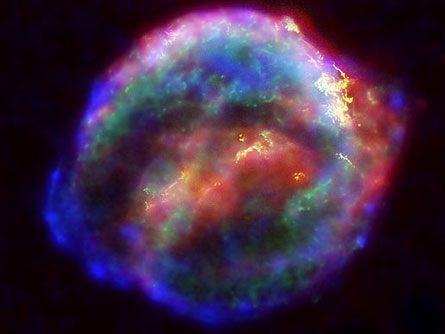 |
|
When a star explodes in a supernova, it ejects neutrinos that travel through space at nearly the speed of light. Scientists try to analyze the neutrinos when they pass through the Earth.
|
| NASA |
Scientists can use the same technique to find exploding stars. The most common type of neutrino forms within the cores of stars like our sun. When the star “dies,” it can explode into a bright ball called a supernova. Like black holes, supernovas are difficult to observe. The sky is big and only two or three supernovas may occur in our galaxy every century. What’s more, their explosions may last only a few seconds. But like black holes, supernovas eject streams of neutrinos, which can serve as a sort of energy “fingerprint” by which the supernova can be traced.
Neutrinos from supernovas, however, have much less energy than those spewed by black holes. That’s one way scientists can tell them apart.
In 1987, astronomers found a nearby supernova. The stream of neutrinos it had emitted were detected all around Earth. Those neutrinos arrived at the Earth a few hours before light from the supernova did, apparently because the neutrinos weren’t slowed down through interactions with dust and other matter along the way. So neutrinos can provide a first alert for astronomers, suggesting where they should point their telescopes to catch major upcoming events.
Scientists working on IceCube hope their machine will also solve one of the biggest mysteries in outer space. “Cosmic rays” are powerful streams of radiation that blow through the universe. Many scientists suspect that they’re leftover radiation from old supernovas. To find out, they hope to find neutrinos from these old explosions and match them to the cosmic rays.
“We expect to detect neutrinos from these sources.” Doing so would provide not only the first solid evidence but indeed “the smoking gun for that theory,” Halzen says.
While scientists are excited about looking for such things, they’re even more excited at the idea of stumbling onto unexpected deep-space surprises with IceCube.
“To me the really fascinating thing would be to discover something that hasn’t been seen with any other technique,” Madsen says. He likens that to the excitement experienced when people peered through the first microscopes.
Looking for a faint blue light
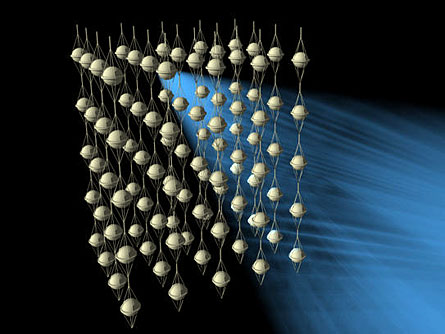 |
|
IceCube is made up of a grid of sensors that can detect the blue light from a collision between a neutrino and an atom.
|
| NSF |
Neutrinos are one type of subatomic particle (see “The Particle Zoo”). The name means “little neutral one.” They’re described as neutral because they don’t have a positive or a negative electric charge.
Finding neutrinos is tricky, but not impossible. Most pass through matter without running into anything. Occasionally, however, a neutrino smashes into an atom. This collision produces an unusual phenomenon: a flash of eerie blue light. This glow is called Cerenkov (chair ENK uf) radiation.
Instead of trying to stop neutrinos, which is almost impossible, scientists scout for this blue light. Although faint, it can travel dozens of meters (hundreds of feet) through water or ice if the conditions are right. Because Cerenkov radiation is so faint, however, neutrino detectors must be shielded from other types of light and energy that might mask the blue light.
To screen other light out, scientists have taken their neutrino quest underground, because Earth acts like a giant filter. Earth or its atmosphere absorbs most particles that zip through the universe towards our planet. Only tiny particles like neutrinos can easily pass through. IceCube’s position at the South Pole means it can find neutrinos that entered Earth in the north and traveled all of the way through our planet.
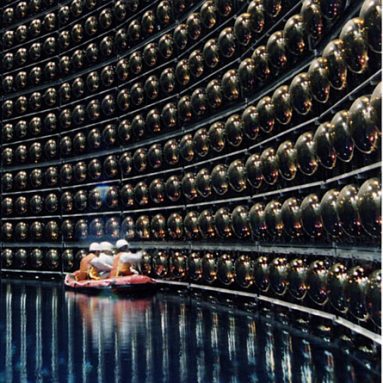 |
|
Technicians at the Super-Kamiokande neutrino detector have to take a boat to repair one of its thousands of light sensors.
|
| Kamioka Observatory, ICRR (Institute for Cosmic Ray Research), University of Tokyo |
An older neutrino spotter lies beneath a mountain in Japan. Its giant, spherical tank holds about 50 million liters (13 million gallons) of water, enough to fill 20 Olympic-size swimming pools. The inside of the tank is lined with thousands of beach-ball–sized detectors that can pick up even the faintest flash of blue light.
Many neutrino-scouting devices look like the one in Japan: large tanks, deep underground. Some contain regular water, others a type enriched with a heavy form of hydrogen (known as deuterium). Until last year, scientists used such a tank, located in Canada. At an abandoned gold mine in South Dakota, scientists are building a similar underground neutrino-scouting system. And on the floor of the Mediterranean Sea, European scientists are installing an underwater neutrino detector with sensors that float on long strings.
Although all of the tank-based systems are remote, they can be seen. But if you go to the South Pole to visit IceCube, prepare to be disappointed. Scientists are burying this detector more than a mile beneath the snowy surface. If you were standing on top of it, you’d never know it. There are a few buildings around and a landing strip for an airplane, but those are the only clues.
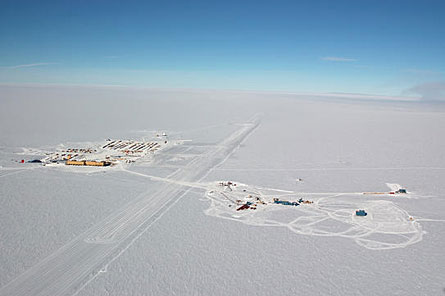 |
|
You’d never guess that buried beneath the snow and ice is the world’s largest scientific instrument.
|
| NSF |
That’s not the only thing that sets IceCube apart from other neutrino detectors. At nearly all of the others, the telltale blue neutrino fingerprint is identified as it passes through water. At IceCube, Francis Halzen and his team are taking a different approach. They’re building IceCube inside an enormous glacier.
First, the scientists drill a deep hole in the ice with hot water. Next, they lower into this hole a string of about 60 detectors, each the size of a beach ball. As ice refreezes around the string, the detectors are locked into place, waiting for a neutrino to whiz by.
Here, ice takes the place of the water in more conventional detectors. When a passing neutrino collides with some atom, its faint blue light begins speeding through the frozen glacier. Light detectors, frozen in place, chart the path of this small flash. By analyzing which detectors saw the light, scientists can track the neutrino’s path, which will point straight back at its source.
“This ice is fantastically clear,” says Halzen. “In our detector the blue light travels over 100 meters [328 feet].”
Burying IceCube this way requires a lot of work, but Halzen says the science it will deliver is worth the effort. For scientists like Halzen, Madsen and Cowen, that small, faint flash could bring big discoveries about the farthest reaches of outer space.
“It’s almost a certainty that we will see things no one has expected before,” Cowen says. “We are more or less opening up this window on the universe and seeing what flies in.”







